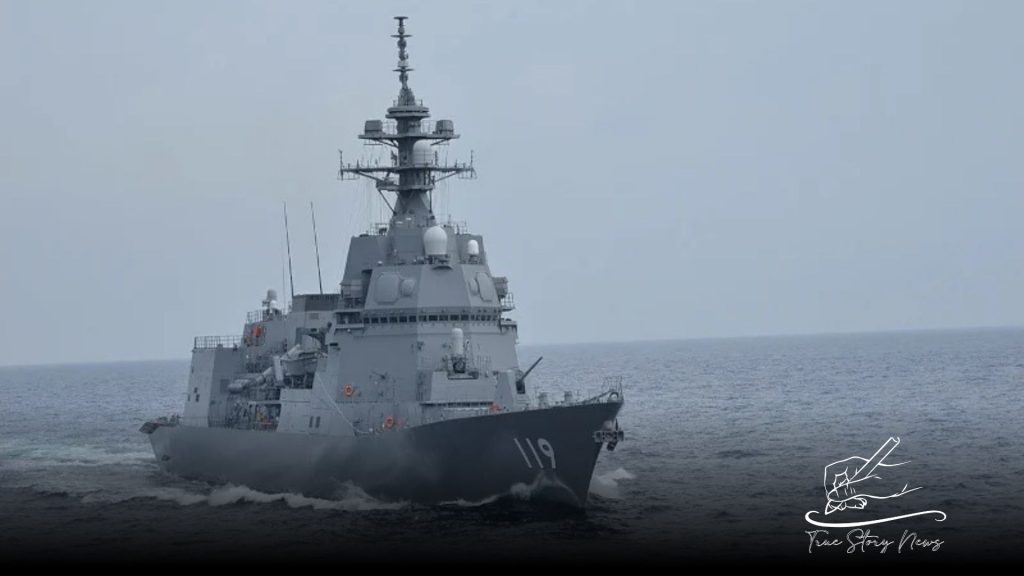Reports from Japanese media indicate that a Japanese warship has navigated the Taiwan Strait, marking the first instance of such a passage between Taiwan and China.
On Wednesday, the JS Sazanami, a naval destroyer, navigated the strait from north to south, flanked by vessels from Australia and New Zealand.
According to statements from Japanese ministers, the vessel was en route to participate in military exercises in the South China Sea.
Japan’s potential decision to navigate its vessels through the strait marks a noteworthy shift in its maritime strategy. This move comes amid concerns that such actions could provoke China, which asserts its claim over self-governed Taiwan and the surrounding waters.
As of now, Japan, Taiwan, and China have not officially commented on the passage.
The Global Times, a state-run newspaper in China, reported, referencing an unnamed source, that the Chinese military “conducted tracking and monitoring throughout [the vessels’] entire course and had the situation under control.”
The United States and its allies have intensified patrols in the 180-kilometer (112-mile) Taiwan Strait as they seek to reinforce their commitment to freedom of navigation in the region.
The United States and Taiwan assert that this route is crucial for shipping and trade, facilitating the passage of approximately half of the world’s container fleet. They emphasize that it constitutes international waters accessible to all naval vessels.
Beijing asserts its sovereignty and jurisdiction over the strait, expressing disagreement with opposing views.
For many years, the US Pacific fleet stood as the sole foreign navy consistently navigating the strait. Recently, Canada, Australia, Britain, and France have joined the ranks. Germany recently made headlines by sending two navy ships through the strait, marking the first such passage in decades.
China’s military has levelled accusations against Germany, claiming that the latter’s navigation through the strait on 13 September has heightened security risks. In response, Berlin has asserted that its actions were in line with international standards. A German naval vessel has made its first passage through the strait in 22 years.
The recent transits carry significant political weight, signalling to China that the United States and its allies reject Beijing’s territorial claims.
Japan is taking a significant step away from its longstanding policy of refraining from directly confronting China.
On Thursday, Japan’s chief cabinet secretary refrained from providing specifics regarding the naval operation. However, he expressed that Japan is experiencing a heightened sense of crisis following a series of airspace violations by the Chinese military, which he noted have occurred in quick succession.
Taiwan has remained silent regarding the recent developments; however, its defence ministry reported on Wednesday a notable increase in the activity of Chinese military aircraft in the vicinity of the island.
Bec Strating, a professor of international relations at La Trobe University in Australia, commented on Japan’s reported transit, describing it as “part of a broader pattern of greater naval presence by countries in and beyond Asia that are concerned about China’s maritime assertions.”
“Japan has been addressing China’s ‘grey zone’ tactics in the East China Sea,” she stated to the AFP news agency.
Analysts indicate that grey zone warfare tactics are designed to erode an adversary’s strength gradually over an extended timeframe.
In a significant move, Beijing dispatched an aircraft carrier to navigate between two Japanese islands close to Taiwan last week, marking a notable first in the region’s maritime activities. In August, a Chinese spy plane entered Japan’s airspace, leading Tokyo to denounce the breach as “utterly unacceptable” and a “serious violation of sovereignty”.
Last week, the leaders of the Quad nations—Japan, Australia, India, and the United States—announced plans to enhance collaboration on maritime security in response to China’s growing assertiveness in the South China Sea.













